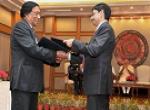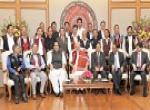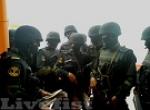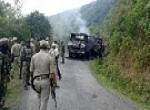When Manipuri insurgent organisation PLA’s commander-in-chief, Manohar Mayum met journalists in Myanmar’s Somra Tracts (opposite Ukhrul) and proclaimed his group’s alliance with CPI (Maoist) to fight the “common enemy”, the speculation that had been doing the rounds about Maoist inroads into the North East became a reality. Mayum was quite categorical about the alliance. He said (the statement below is a verbatim replication of what the PLA leader said in a video-taped statement, excerpts of which are in the possession of the author) “We have been maintaining relations with CPI (Maoist) for some years. But from 2008 this has become stronger and it has been upgraded to a new level. We should unite against a common enemy. This unity should be part of our campaign against our enemy even as we fight for our legitimate cause.”
While it is not immediately known as to what the “upgradation to a new level” actually entails, analysis has it that it could involve not only joint training in the new training facilities of PLA in Kachin and sharing of bases, but joint operations as well. After all, PLA is one group whose principles closely approximate that of the Maoists, by way of its ultra-left ideology. One anecdotal report has stated that Manipuri people (it is not known from which grouping) have been seen alongside Maoist cadres in West Bengal. It is also learnt that CPI (Maoist)’s Eastern Regional Bureau has been tasked with the responsibility of engineering association with insurgent groups in the North East with a clear objective of securing ground in the region. The alliance with the Meitei group, in all probability, was one of the Bureau’s successes. The Maoists “Unity Congress” that was formed in September 2004, “declared” its support to insurgencies by “various nationalities”, including those by ULFA, NSCN (both factions) and PLA (Manipur), stating, “This Congress reaffirms its whole-hearted support to all these nationality movements and their right to self-determination, including the right to secession.” The Congress supported the “right of self-determination of all the oppressed nationalities, including their right to secede from the autocratic Indian State.” If the report about Manipuris being sighted among Maoists in West Bengal has any truth to it, then the cross-pollination between left-wing-extremist groups in heartland India and insurgent groups in the North East has started.
It is also learnt that Koteswar Rao @ Kishenji, the military wing chief of CPI (Maoist) has communicated with ULFA chief of staff, Paresh Barua (interestingly Baruah identified himself as Deepak). The PLA communiqué above and reports about increasing contact between North Eastern insurgent groups and the Maoists clearly indicate that one of India’s primary internal security threats is attempting to systematically engage insurgent groups in the region, and gain a foothold in the area. Indeed, Maoist alliance with ULFA reportedly dates back to at least the days preceding the 2 April 2004 arms haul in Chittagong. Reliable reports have stated that a sizeable portion of the arms—Paresh Baruah and Anthony Shimray of NSCN (IM) have been named by apprehended Bangladeshi arms dealer, Hafizur Rahman as the two primary recipients—was meant for the Maoists. While not much is immediately known about the exact sum and substance of the conversation between Baruah and Rao alluded to above, one condition that was reportedly put forward by Rao to the ULFA chief of staff was that ULFA must stop targeting Hindi-speaking people, which it had been doing with impunity in order to attract New Delhi’s attention. Kishenji told Baruah that the Hindi-speaking people, mostly from Bihar (and ones that have been systematically targeted by ULFA, NDFB, KLNLF etc), constitutes the parish for the Maoists, and it would be incorrect to kill people of such hue, who are themselves bearing the brunt of New Delhi’s “exploitation”.
Interestingly, ULFA has not targeted people from the Hindi-speaking community since the aforesaid communication between Kishenji and Paresh Baruah, although the recent killings of 24 people in Assam—a majority of whom were Hindi speakers—by NDFB (at least in the opinion of the author) had an ULFA component. Paresh Baruah is close to the anti-talk faction of NDFB, has great affinity with the group’s leader, Ranjan Daimary, and it is the author’s considered opinion that the two groups are operating in concert in conducting such operations. But to keep the records straight, incarcerated anti-talk NDFB chairman, Ranjan Daimary—during the course of a televised interview on 25 November 2010—denied any such links with ULFA. But, he also stated that he has presently no control over his cadres as he is in jail.
But to return to the question of Maoist inroad into the North East, it is the author’s analysis that alliances and arms-trading, with attendant aspects like training, base-sharing, conduit to China and even combined operations, is not tantamount to establishing robust ground inside the North East. The primary reason for this is because the North East does not provide a ready fertile ground for the Maoist to thrive. After all some of the realities that characterise areas like Jharkhand, Chhattisgarh and thereabouts in which left-wing-extremism is flourishing are not evident in even an unrest-ridden milieu like the North East. While rampant corruption and exploitation pervade the enchanted frontiers, much of the ire is trained against non-North Easterners, for instance the Marwari community (who control a majority of the resources in the region: on 25 November 2010 activists belonging to AASU ransacked several shopping complexes run by people belonging to the Marwari community in different parts of Assam) or people from Bihar (who came as petty labourers, and who are slowly being replaced by illegal Bangladeshi migrants). Therefore, not only are the conditions—including the fact that poverty and personalised exploitation are not as all pervading and ingrained in the North East as it is in areas where Maoism has taken strong roots, but a sense of social justice continues to characterise the region. This is perhaps because of the policy of the British to administer much of the region in partial exclusion (as it saw no profit in occupying the hill areas of the region), choosing to send punitive expeditionary missions only to control marauding Naga raiders when the latter descended on tea plantations in mainland Assam. In most states in the region there is an inner-line permit regime in place and outsiders cannot purchase or own land. This prevents land takeovers, which acts as a protective mechanism against outside control (it is another matter that illegal Bangladeshi migrants are coming in hordes and settling in the region, albeit with patronage from certain quarters).
Another reason why Maoism will not be able to gain a foothold in the North East is because of Christianity, which is the primary religion among almost all tribes of the region barring the caste Assamese, a few Bodos, certain Bengalis of Assam and Tripura, who are Hindus, and the animistic religious communities of Arunachal Pradesh. Although even the tribes of central India also have Christianity in their midst, the fact of the matter is that the socio-economic conditions that prevail in the region have led the constituency to embrace Maoism, which in the opinion of the author is actually tribal insurgency, a phenomenon that had characterised the area even during the days of the British with rebellion such as the Santhal uprising. It will also be recollected that the Naga insurgency disassociated themselves from China because they were unwilling to replace “Nagaland for Christ” with communism. In a non-industrialised milieu, where religion and social egalitarian standards are important drivers, Maoism would have to bet hard to find a place in the North Eastern sun.
Alongside conditions, space is an important component for Maoism to grow. Every inch of land in the North East already has an indigenous movement with well-focussed localised objectives. An insurgent group such as ULFA—despite hobnobbing with CPI (Maoist) on matters of exigency such as arms-dealing—would not allow the Maoists to set up base in the state. ULFA despite their avowal to a Marxist-Leninist ideology, have little or no idea of scientific socialism. Celebrated author, Udayon Misra has written about this in a telling manner in his seminal book “The Periphery Strikes Back: Challenges to the Nation-State in Assam and Nagaland.” He writes (and a somewhat extended quote is necessary at this juncture to disabuse ULFA’s ideological leanings)
“The AJYCP (Asom Jatiyotabadi Yuva Chattra Parishad) roots of the ULFA should help one in understanding the latter’s emphasis on “scientific socialism’ from time to time—something which has been picked up by social scientists and journalists to give the ULFA a Marxist or Communist veneer, while in reality it is a militaristic outfit. Just like the AJYC, the ULFA too is said to be attempting a blend of Maoism and Assamese nationalism. For instance, the CPI (ML) leader, Vinod Mishra has said that ULFA’s “faith on Mao’s thought has led them to provide a new turn to the erstwhile Assam movement, a left turn indeed, doing away with its anti-communist, anti-left communal bias of the early 80’s. Thus, parties like the CPI (ML) have tried to project ULFA as a “representative organisation of the Assamese people” which has taken “Mao’s ideology as its prime weapon in its fight against the all-India supra-national forces...An analysis of the structure and class character of the ULFA does not show it either as a communist or even radical Marxist organisation, though it has been quite common for the insurgent groups of the northeastern region of the country to claim left credentials. The colonial thesis and the stress on armed struggle to achieve one’s ends have quite often been factors which have led sections to the communist left in our country to conclude that such organisations share the Maoist-Marxist ideology. Referring to the ULFA’s claims to “scientific socialism,” ULFA maintains that its aim of liberating Assam and making it independent is only the first stage being implementation of the principles of scientific socialism. The literature that is available from the organisation suggests that it has a fairly simple notion of what scientific socialism is all about.” (Udayon Misra, pp 134-135)
There is an accentuated class distinction among ULFA’s rank and file, and praxis does not form a part of its functional apparatus. Indeed, ULFA has assassinated candidates of even the CPI (ML), like Anil Baruah in Dibrugarh during the run-up to the general elections in1998 in order to halt the march of the reds into Assam. Although there was a Marxist-Leninist enterprise in the state—of the parliamentarian form, particularly in Karbi Anglong—it soon decayed in the face of centrist politics. An organisation such as ULFA would never abdicate space to any other group, leftist or otherwise—its territorial claims are non-negotiable, and furthermore ULFA does not evince itself as a part of the Communist International even though it projects itself as leftist outfit with socialist standards. At any rate, the present character of ULFA and its chieftain, Paresh Baruah approximates that of a pure warlord who eliminates detractors, governs his organisation by way of whims and fancies and acts financially and politically in the international system without interference. Therefore, even if Paresh Baruah is talking to Koteswar Rao, it would be not about sharing space, but about arms-deals, joint training and safe havens. In the present circumstances (despite reports that even the ISI has held meetings with the Maoists), ULFA would never countenance truck with the Maoists, especially as it has realised the latter’s power in the Indian heartland. In fact it would resist it. The conditions and the space aspect would, therefore, not permit the ingress of Maoism in the North East in the manner it has spread to other parts of the country. Practical considerations may, however, lead to alignments, but not superimpositions.
Even groups such All Adivasi National Liberation Army (AANLA) (it had sent at least 24 of its cadres to Jharkhand to train alongside the Maoists) that has natural affinity to central India, being from the Santhal stock, and were brought to Assam by the British to work the tea gardens have shown little interest in the “dictatorship of the proletariat” and are in either in a surrender mode or have been arrested for graduating into contract killing (Nirmal Tirkee, the leader was arrested in Ranchi in the second week of December 2008). Maoism means little for them in the Assam scenario. Clearly they had gone for training with the Maoists in order to acquire muscle against the Bodos that were taking them on. The hard core Maoists of Dantewada and thereabouts—where the Adivasis trained—did not fathom their real objectives. Indeed, 16 of the trained 24 Adivasi cadres surrendered to the authorities. Anyone with a sense of communism would know that the modus operandi of the AANLA was not in line with Karl Marx’s Communist Manifesto that was worked upon in Hyde Park, London. Adivasi sentiments in Assam are locally placed, and against Bodos, and even a stray incident that resulted in an Adivasi women being molested in Guwahati during the Beltola (Guwahati) riots of 2007—has no connection with the commune. Indeed, the unfortunate Adivasi lady who was humiliated was approached by the communal Assam United Democratic Front (headed by Badrudin Azmal) in order to contest elections. The Adivasis approached the Maoists only because they felt there was social affinity—they belonged to the same stock. But once they returned to Assam, they realised that they could not impose the ideological training that they were imparted by the comrades on their community in Assam.
The phenomenon is exactly at par with what became of certain indigenous Assamese Muslims who had gone to POK to train alongside LeT, JeM and groups whose motivations were guided by the global salafi movement. The Assamese Muslims came back and surrendered to the authorities. On being questioned about the reason, they said that they had gone to train so that they can come back and aid their Muslim brethren in Assam. Instead, their ISI instructors had pressed them to perform acts like assassinate senior national political leaders and attain shahadat by indulging in suicide terrorism. Such instructions meant nothing for the indigenous Assamese Muslim and being disenchanted they returned to the mainstream.
The attempts by the Maoists to make inroads into the North East are clear. But, what is not clear is the success of the exercise. Clearly insurgent groups like PLA are aligning with CPI (Maoist) only for practical consideration, despite the fact that PLA, too (as aforesaid), wears a leftist veneer, albeit not of the rabid Maoist variety, but one which suits the locale.
How about the changing course of proletariat politics in the region, especially Assam?
The blazing sun in the horizon that is storm-trooping Assam, the Krishak Mukti Sangram Samiti (KMSS) and its general secretary Akhil Gogoi, whose leftist ideology are not in doubt, do not have any (despite myriad accusations against them) links with the Maoists. The author has confirmed this with traditional central agencies that monitor such matters as well, although provincial intelligence might seek to colour the movement, or attempt to draw connections with the Maoists in order to bludgeon the movement.
Mass movements against corruption and mega dams that are currently dominating Assam’s firmament in a furious manner have not indicated any truck with the Maoists. It is mass anger against what a section of the Assamese people is incorrect action. This analysis, incidentally, does not subscribe to aspects such as stoppage of mega dams that are being tom-tommed by KMSS: for the simple reason that development has to take precedence over certain exigencies such as internal displacement (with correct compensation). If necessary the occasional bitter-pill has to be swallowed, which in the North Eastern context translates into internal displacement, earthquakes, and down-stream-disturbance. The demand of groups should, therefore, not be the stoppage of all mega dams, but demand for the institution of feasibility studies before projects such the Lower Subansiri Hydel Power Project is completed. It is a happy sign that the Environment Minister, Jairam Ramesh has engaged people like Akhil Gogoi and assured that he would be envoying the grievances of the people of Assam to New Delhi. These are positive signs of centrist concerns for the periphery. But, the non-violent manner of protest by the KMSS on issue relating to mega dams or corruption must appeal to the government and press it to undertake remedial measures.
It is evident that the Maoists in heartland India are closely monitoring the situation and one can also be certain that the Maoist leadership have tried to influence KMSS, and would undertake measures to provoke the farmer’s organisation into resorting to non-traditional methodology. Fortunately it has not succeeded in its endeavour so far. It is precisely because of these reasons that the state must recognise the fault lines and take a correct course correction action in right earnest. The logic of “winning the argument” must not be allowed to await a time when dissonance has already graduated into violent movements. This has been the bane of centrist policy for the North East for decades, with negative results.
--------------------------------------------
Published Date : December 3, 2010









Post new comment